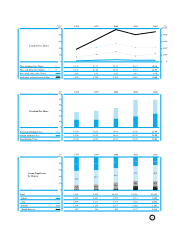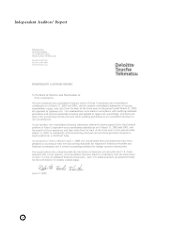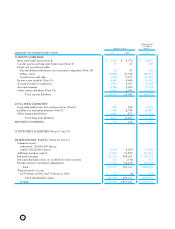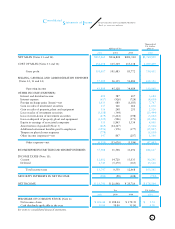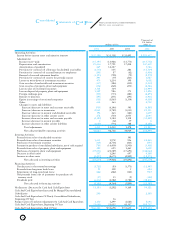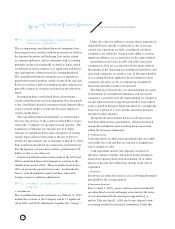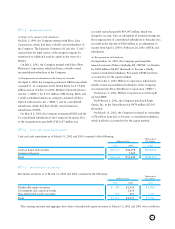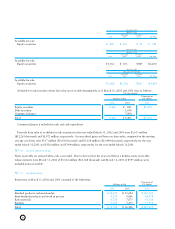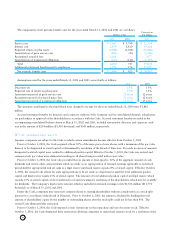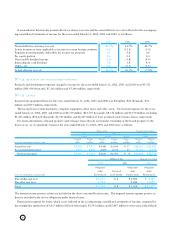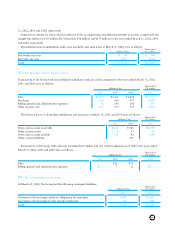Pentax 2002 Annual Report Download - page 40
Download and view the complete annual report
Please find page 40 of the 2002 Pentax annual report below. You can navigate through the pages in the report by either clicking on the pages listed below, or by using the keyword search tool below to find specific information within the annual report.
38
standard, all securities are classified as available-for-sale
securities and are reported at fair value, with unrealized gains
and losses, net of applicable taxes, reported in a separate
component of shareholders’ equity. The cost of securities sold
is determined based on the moving-average method. The
effect of this change was to increase income before income
taxes by ¥987 million for the year ended March 31, 2001.
Non-marketable available-for-sale securities are stated at
cost determined by the moving-average method.
For other than temporary declines in fair value, investment
securities are reduced to net realizable value by a charge to
income.
e. Property, Plant and Equipment
Property, plant and equipment are stated at cost. Deprecia-
tion of property, plant and equipment of the Company and its
consolidated domestic subsidiaries is computed substantially
by the declining-balance method at rates based on the
estimated useful lives of the assets, while the straight-line
method is applied to buildings of the Company and its
domestic subsidiaries, and to all property, plant and equip-
ment of consolidated foreign subsidiaries. The net book
value of tangible fixed assets depreciated by the straight-line
method was approximately 42.8% of total tangible fixed
assets in 2002 and 37.1% in 2001. The ranges of useful lives
are from 10 to 50 years for buildings and structures and from
5 to 10 years for machinery and vehicles.
f. Intangible Assets
Intangible assets are carried at cost less accumulated amorti-
zation, which are calculated by the straight-line method.
Amortization of software is calculated by the straight-line
method over 5 years.
g. Retirement Benefits
The Company and certain consolidated subsidiaries have
contributory funded pension plans and unfunded retirement
benefit plans which cover substantially all of their employees.
Other subsidiaries have unfunded retirement benefit plans.
Prior to April 1, 2000, amounts contributed to the plan were
charged to income when paid. Certain consolidated subsid-
iaries have unfunded retirement benefit plans and have
recorded a liability for retirement allowances at 100% of the
amount which would be required if all employees voluntarily
terminated their employment at the balance sheet date prior
to April 1, 2000.
Effective April 1, 2000, the Company and domestic
consolidated subsidiaries adopted a new accounting standard
for employees' retirement benefits and accounted for the
liability for retirement benefits based on projected benefit
obligations and plan assets at the balance sheet date. The
transitional obligation of ¥3,166 million, determined as of
April 1, 2000, is being amortized over 15 years and presented
as other expense in the consolidated statements of income.
As a result, net periodic benefit costs, as compared with the
prior method, decreased by ¥1,742 million and income before
income taxes and minority interests increased by ¥1,603
million for the year ended March 31, 2001.
The annual provision for accrued retirement benefits for
directors and corporate auditors of the Company and its
consolidated domestic subsidiaries is also calculated to state
the liability at the amount that would be required if all
directors and corporate auditors retired at each balance sheet
date. The provisions for the retirement benefits are not
funded.
h. Research and Development Expenses
Research and development expenses are charged to income
when incurred.
i. Leases
All leases are accounted for as operating leases. Under
Japanese accounting standards for leases, finance leases that
deem to transfer ownership of the leased property to the
lessee are to be capitalized, while other finance leases are
permitted to be accounted for as operating lease transactions
if certain “as if capitalized” information is disclosed in the
notes to the lessee’s consolidated financial statements.
j. Income Taxes
The provision for income taxes is computed based on the
pretax income included in the consolidated statements of
income. The asset and liability approach is used to recognize
deferred tax assets and liabilities for the expected future tax
consequences of temporary differences between the carrying
amounts and the tax bases of assets and liabilities. Deferred
taxes are measured by applying currently enacted tax laws to
the temporary differences. Effective April 1, 1999, the Group
adopted the new accounting standard for interperiod alloca-
tion of income taxes based on the asset and liability method.
The cumulative effect of the application of interperiod tax
allocation in prior years in the amount of ¥6,718 million is
included as an adjustment to retained earnings as of April 1,
1999. Such cumulative effect is calculated by applying the
income tax rate stipulated by enacted tax laws as of April 1,
1999.


